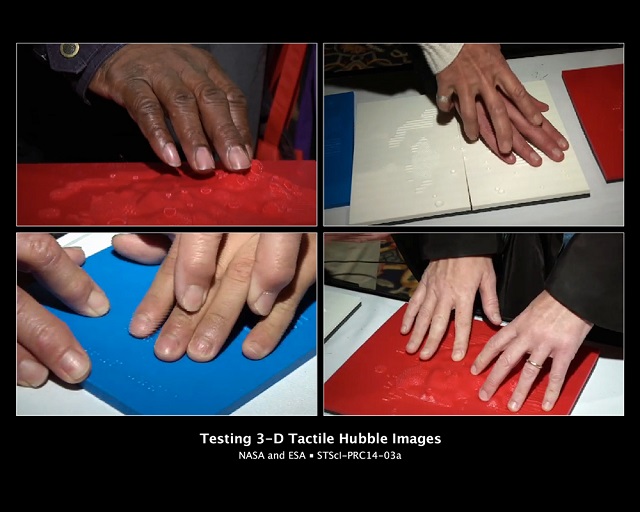 People with visual impairments use their fingers to explore 3-D tactile representations of images taken by NASA's Hubble Space Telescope. (Image Credit: NASA, ESA, and M. Estacion/STScI)
People with visual impairments use their fingers to explore 3-D tactile representations of images taken by NASA's Hubble Space Telescope. (Image Credit: NASA, ESA, and M. Estacion/STScI)
With the objective of revolutionizing astronomy education, the Space Telescope Science Institute researchers, Antonella Nota and Carol Christian, convert Hubble Space Telescope pictures into tactile 3-D images using 3D printers in order to help visually impaired people to explore space objects.
It is a difficult task as visualizing celestial bodies in three dimensions poses challenges to astronomers themselves, said the researchers. The 3-D print design is also valuable and interesting for normal people having different learning methods, the scientists added.
Using a small Hubble education and public outreach grant, the astronomers bought a 3-D printer for the initiative and created Hubble tactile images using the innovative technology. The first 3-D tactile picture created by them was for the NGC 602, a bright star cluster in the Small Magellanic Cloud galaxy. A great amount of trial and error was involved in this process.
It's very easy to take any tool or object that you can actually measure and produce a 3-D printout. But it's very hard to think of an astronomical object about which you know very little. You can measure the sizes and brightnesses of space objects from the images, as well as some of the distances. But it's really hard to understand their 3-D structure. The work is scientific, but it's also guesswork and artistry to try to produce an object, which printed, will look like the image that Hubble has taken. So, we are basically designing the process from scratch.
Antonella Nota of the Space Telescope Science Institute in Baltimore
Since then, the researchers have created various 3-D tactile prototypes in plastic, by 3D printing textures like raised open circles, dots and lines to represent the stars, dust, gas, and filaments. For this initiative, Nota and Christian formed a team involving software design experts and specialists who develop programs for visually impaired people.
Perry Greenfield, the science software branch manager of the Space Telescope Science Institute created the software that helps converting the measurements derived from Hubble Telescope pictures into objects that could be printed by the 3-D printers. Using this software, the Hubble 3-D tactile prototype representations are created for the 3-D printouts and texture maps with the textured features and their corresponding brightness.
Renowned astronomy author, Noreen Grice played a role in the selection of textures for representing the individual features in the 3-D images from the Hubble Space Telescope. The team demonstrated the potential of the 3-D tactile prototypes in the transformation of astronomy education by successfully testing them with visually impaired people. The 3-D tactile prototypes had received overwhelming response from many visually impaired people.
The team has refined the 3-D representations from the inputs gained from the testing. The main challenge was in the selection of the appropriate textures, said Greenfield. The team used crater look-alikes instead of a flat circle to represent the stars, he added.
According to Natalie Shaheen, who serves as director of education for the National Federation of the Blind, the 3-D printing technology allows visually impaired people to access information. Grice believes that tactile astronomical images have been greatly improved using the 3-D technology, benefiting both normal and visually impaired people.
Creating 3-D tactile images of all Hubble pictures and making them accessible online to the public, libraries and schools to take printouts using 3-D printers is the long-term objective of the duo.
References